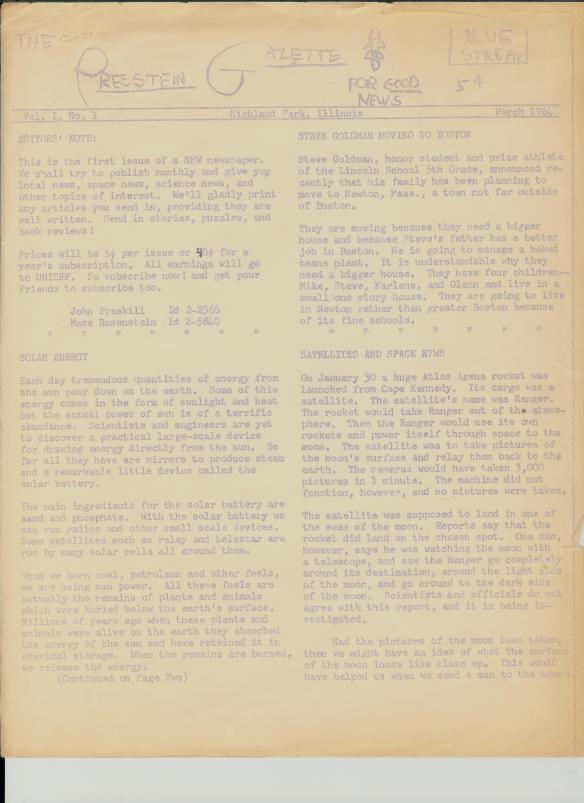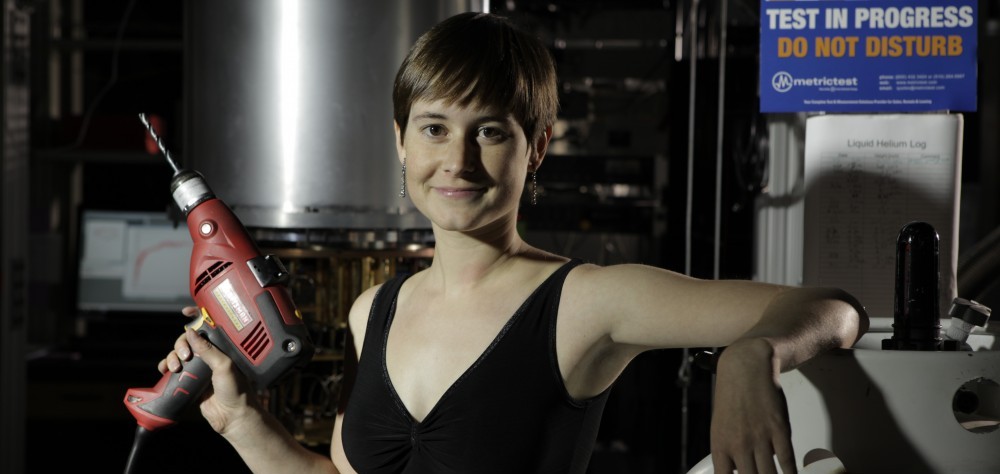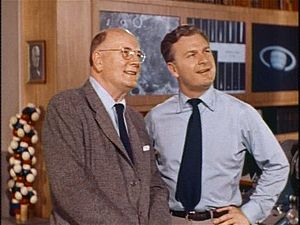This year marks the 50th anniversary of my first publication. In 1964, when we were eleven-year-old fifth graders, my best friend Mace Rosenstein and I launched The Pres-stein Gazette, a not-for-profit monthly. Though the first issue sold well, the second issue never appeared.

Front page of the inaugural issue of the Pres-stein Gazette. Faded but still legible, it was produced using a mimeograph machine, a low-cost printing press which was popular in the pre-Xerox era.
One of my contributions to the inaugural issue was a feature article on solar energy, which concluded that fossil fuel “isn’t of such terrific abundance and it cannot support the world for very long. We must come up with some other source of energy. Solar energy is that source … when developed solar energy will be a cheap powerful “fuel” serving the entire world generously forever.”
This statement holds up reasonably well 50 years later. You might wonder how an eleven-year-old in 1964 would know something like that. I can explain …
In the 1950s and early 1960s, AT&T and the Bell Telephone System produced nine films about science, which were broadcast on prime-time network television and attracted a substantial audience. After broadcast, the films were distributed to schools as 16 mm prints and frequently shown to students for many years afterward. I don’t remember seeing any of the films on TV, but I eventually saw all nine in school. It was always a treat to watch one of the “Bell Telephone Movies” instead of hearing another boring lecture.
For educational films, the production values were uncommonly high. Remarkably, the first four were all written and directed by the legendary Frank Capra (a Caltech alum), in consultation with a scientific advisory board provided by Bell Labs. Those four (Our Mr. Sun, Hemo the Magnificent, The Strange Case of the Cosmic Rays, and Unchained Goddess, originally broadcast in 1956-58) are the ones I remember most vividly. DVDs of these films exist, but I have not watched any of them since I was a kid.
The star of the first eight films was Dr. Frank Baxter, who played Dr. Research, the science expert. Baxter was actually an English professor at USC who had previous television experience as the popular host of a show about Shakespeare, but he made a convincing and pleasingly avuncular scientist. (The ninth film, Restless Sea, was produced by Disney, and Walt Disney himself served as host.) The other lead role was Mr. Writer, a skeptical and likeable Everyman who learned from Dr. Research’s clear explanations and sometimes translated them into vernacular.
The first film, Our Mr. Sun, debuted in 1956 (broadcast in color, a rarity at that time) and was seen by 24 million prime-time viewers. Mr. Writer was Eddie Albert, a well-known screen actor who later achieved greater fame as the lead on the 1960s TV situation comedy Green Acres. Lionel Barrymore appeared in a supporting role.
Our Mr. Sun must have been the primary (unacknowledged) source for my article in the Pres-stein Gazette. Though I learned from Wikipedia that Capra insisted (to the chagrin of some of his scientific advisers) on injecting some religious themes into the film, I don’t remember that aspect at all. The scientific content was remarkably sophisticated for a film that could be readily enjoyed by elementary school students, and I remember (or think I do) clever animations teaching me about the carbon cycle in stellar nuclear furnaces and photosynthesis as the ultimate source of all food sustaining life on earth. But I was especially struck by Dr. Baxter’s dire warning that, as the earth’s population grows, our planet will face shortages of food and fuel. On a more upbeat note he suggested that advanced technologies for harnessing the power of the sun would be the key to our survival, which inspired the optimistic conclusion of my article.
A lavishly produced prime-time show about science was a real novelty in 1956, many years before NOVA or the Discovery Channel. I wonder how many readers remember seeing the Dr. Frank Baxter movies when you were kids, either on TV or in school. Or was there another show that inspired you like Our Mr. Sun inspired me? I hope some of you will describe your experiences in the comments.
And I also wonder what resource could have a comparable impact on an eleven-year-old in today’s very different media environment. The obvious comparison is with Neil deGrasse Tyson’s revival of Cosmos, which aired on Fox in 2014. The premiere episode of Cosmos drew 8.5 million viewers on the night it was broadcast, but that is a poor measure of impact nowadays. Each episode has been rebroadcast many times, not just in the US and Canada but internationally as well, and the whole series is now available in DVD and Blu-ray. Will lots of kids in the coming years own it and watch it? Is Cosmos likely to be shown in classrooms as well?
Science is accessible to the curious through many other avenues today, particularly on YouTube. One can watch TED talks, or Minute Physics, or Veritasium, or Khan Academy, or Lenny Susskind’s lectures, not to mention our own IQIM videos on PHD Comics. And there are many other options. Maybe too many?
But do kids watch this stuff? If not, what online sources inspire them? Do they get as excited as I did when I watched Dr. Frank Baxter at age 11?
I don’t know. What do you think?


Star Trek The Next Generation / science fairs / my mom / pop-physics books
Very cool, Prof Preskill. Maybe you want to digitize the text. It would be a welcome guest blog post. 😉
Those Lenny Susskind lectures are awesome. Despite being an MD, Physics is what ticks me and many more back at home-a plagued place. But there, rest alone science videos, the only things we get to see are retard fundamentalists blowing themselves up!
Yes, Lenny is one of a kind.
And sir, saw your quantum computing Watson lecture for general audience. That was lucid and awesome too. Things these like do stir interest in Physics. Thanks. 🙂
Thanks!
That is really cool John. I want to subscribe. I think I can afford 40 cents. What? Wait a minute. It looks like it was 30 cents a minute ago and somebody used a pen to change it to 40 cents. What is going on here?
As for science programs, I have many, many favorites, but I don’t want to hog the airwaves so I’ll mention just one that made a really deep impression on me
http://en.wikipedia.org/wiki/The_Secret_Life_of_Machines
I don’t remember why we changed the subscription price, but vaguely recall that we had to go through a stack of copies and change the price on every one. I haven’t seen The Secret Life of Machines, but from the Wikipedia article it sounds great.
BagattoVeramente i produttori delle materie prime che serviranno al Giappone per la ricostruzione stanno brindando nelle rispettive borse.Così i diretti concorrenti delle aziende esportatrici giapponesi.Questo nelle borse asiatiche.Quelle Occidentali festeggiano i 180 miliardi di liquidità iniettati nel sistema dalla Banca Centrale nipponica.Poi che tutto questo abbia una importanza &quo;trelativa" lo penso io e quindi vale solo per me.Torno a pulire la tunica, a mano per risparmiare!
In Israel at the 60s there was no TV. I think the first prime minister Ben Gurion thought that TV is a bad idea and we did not have one untill the late 60s. (And not a commercial TV until the 90s.) So what took my imagination were books. There were a few I remember well: my favourite was “The dicoverers of the elements” about chemistry, and the other two were excellent too: “The discoverers of electricity” about physics, and the “discoverer of germs” about biology. My uncle in Tel Aviv had many volumes of the “young mechanics” which was a sort of periodical with articles and various facts about science and technology. (We were living in Jerusalem and we visited my uncle once every few months.) I remember reading there about a guy who had filled already three patents when he was seven years and nine months old. I was well below 7 at the time and I remember thinking I have plenty of time to match this achievement, and then I forgot about it and by the time I saw it again I was nine and it was too late. Based on “the discoverers of elements I decided that I want to be a chemist” I had a notebook where I systematically invented new molecules: HO H2O H3O H40 … and in the next line H02 H2O2 H3O2 … and so on. I guess it is closer to combinatorics than to chemistry…Later when I was a young teen I also has some grand projects which never extended beyond a planning stage or a launching that was never followed. As for mathematics the tradition was that a father should teach his son early on at least two out of: a) playing chess, b) riding bicycles, c) swimming and d) evaluating (a+b)^2. I remember that the formula for item d) have made a great impression on me.
Thanks, Gil! I wrote about my favorite science book (which I read about a year before the launch of the Pres-stein Gazette) here:
John, are you sure that wasn’t reproduced on a “Ditto” machine? As I recall, mimeographs were black and white, whereas Dittos could be done in basic colours — and it looks like your document was done using a standard aniline purple backing sheet.
You are probably right. We called these blue copies mimeographs when I was a kid, but that may be technically wrong. The description in Wikipedia of the “Spirit Duplicator” aka “Ditto Machine” seems to match better with what we actually used:
http://en.wikipedia.org/wiki/Spirit_duplicator
Pingback: Dostoevsky, Dickens & Poe Puppets Star in One of Frank Capra’s 1950s Educational Science Films | News Movies - Tech - Android - Phone
Pingback: Puppets of Dostoevsky, Dickens & Poe Star in 1950s Frank Capra Educational Film | Golden Gate Daily
I definitely remember seeing several of these growing up and being impressed with them. I specifically remember that one of the kids from My Three Sons appeared in at least one of them. But the science film I was most impressed with in school growing up was called, if memory serves, “Time Is…” or “Time Is…?” It tackled relativity with the analogy of a twin riding a motorcycle around a track at the speed of light while his brother watches. When he returns to the stands, the racer finds his brother “by now has lost interest” – and is a skeleton, time having moved on. Heady stuff for a sixth grader, but as an adult I haven’t been able to find any reference to the film’s existence.
Karen, that was “About Time,” the last of the films in the series.
I remember being deeply impressed by the twins; their story starts at 43:33 in the video. I did not remember, and would not have noticed in 1962, that Feynman makes an appearance immediately after, starting at 45:18. At the end, he is credited as the scientific advisor for the program.
Gone are the days when libraries and schools were THE sources. I surprised a customer years ago, as I explained the rich history of ATT in domestic and international communications.
Little did this simple, Southern farmer realize, away from his tractor and chores, what he was about to hear about ATT, whose history I followed since childhood. The TV specials and educational films were cornerstones in my life and aspirations in the adult world.
I even included TELSTAR, TELSAT et al in my spiel. We parted ways, him a happy customer, with his DSL internet VPN configured, and me satisfied, after all that media exposure in my childhood, prepping me to articulate on things the adult world offered to me to learn, early!